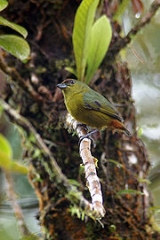
Olive-backed Euphonia
Encyclopedia
The Olive-backed Euphonia, Euphonia gouldi, is a small passerine
bird
in the finch
family. It is a resident breeder in the Caribbean
lowlands and foothills from southern Mexico
to western Panama
.
The Olive-backed Euphonia is found in wet forests, tall second growth and adjacent bushy clearings, typically from sea level to 750 m altitude, sometimes up to 1000 m. The spherical cup nest, with a side entrance, is hidden amongst epiphyte
s or moss
es 2–11 m high in a tree. The normal clutch is three brown-marked white eggs.
The adult Olive-backed Euphonia is 9.5 cm long and weighs 12 g. The adult male has glossy olive upperparts, a yellow forehead, and a rufous belly surrounded by yellow. The adult female has less glossy upperparts than the male, a chestnut forehead, yellow underparts and a small rufous belly patch. Immatures are darker, duller, and have olive underparts.
The Olive-backed Euphonia occurs in small groups, or as part of a mixed-species feeding flock
. This species feeds mainly on small fruit
s.
The Olive-backed Euphonia’s call is a metallic chrrr-chrrr, and the song is mixture of the call with clear or nasal whistles.
The scientific species name commemorates John Gould
, the English
ornithologist.
Passerine
A passerine is a bird of the order Passeriformes, which includes more than half of all bird species. Sometimes known as perching birds or, less accurately, as songbirds, the passerines form one of the most diverse terrestrial vertebrate orders: with over 5,000 identified species, it has roughly...
bird
Bird
Birds are feathered, winged, bipedal, endothermic , egg-laying, vertebrate animals. Around 10,000 living species and 188 families makes them the most speciose class of tetrapod vertebrates. They inhabit ecosystems across the globe, from the Arctic to the Antarctic. Extant birds range in size from...
in the finch
Finch
The true finches are passerine birds in the family Fringillidae. They are predominantly seed-eating songbirds. Most are native to the Northern Hemisphere, but one subfamily is endemic to the Neotropics, one to the Hawaiian Islands, and one subfamily – monotypic at genus level – is found...
family. It is a resident breeder in the Caribbean
Caribbean
The Caribbean is a crescent-shaped group of islands more than 2,000 miles long separating the Gulf of Mexico and the Caribbean Sea, to the west and south, from the Atlantic Ocean, to the east and north...
lowlands and foothills from southern Mexico
Mexico
The United Mexican States , commonly known as Mexico , is a federal constitutional republic in North America. It is bordered on the north by the United States; on the south and west by the Pacific Ocean; on the southeast by Guatemala, Belize, and the Caribbean Sea; and on the east by the Gulf of...
to western Panama
Panama
Panama , officially the Republic of Panama , is the southernmost country of Central America. Situated on the isthmus connecting North and South America, it is bordered by Costa Rica to the northwest, Colombia to the southeast, the Caribbean Sea to the north and the Pacific Ocean to the south. The...
.
The Olive-backed Euphonia is found in wet forests, tall second growth and adjacent bushy clearings, typically from sea level to 750 m altitude, sometimes up to 1000 m. The spherical cup nest, with a side entrance, is hidden amongst epiphyte
Epiphyte
An epiphyte is a plant that grows upon another plant non-parasitically or sometimes upon some other object , derives its moisture and nutrients from the air and rain and sometimes from debris accumulating around it, and is found in the temperate zone and in the...
s or moss
Moss
Mosses are small, soft plants that are typically 1–10 cm tall, though some species are much larger. They commonly grow close together in clumps or mats in damp or shady locations. They do not have flowers or seeds, and their simple leaves cover the thin wiry stems...
es 2–11 m high in a tree. The normal clutch is three brown-marked white eggs.
The adult Olive-backed Euphonia is 9.5 cm long and weighs 12 g. The adult male has glossy olive upperparts, a yellow forehead, and a rufous belly surrounded by yellow. The adult female has less glossy upperparts than the male, a chestnut forehead, yellow underparts and a small rufous belly patch. Immatures are darker, duller, and have olive underparts.
The Olive-backed Euphonia occurs in small groups, or as part of a mixed-species feeding flock
Mixed-species feeding flock
A mixed-species feeding flock, also termed a mixed-species foraging flock, mixed hunting party or informally bird wave, is a flock of usually insectivorous birds of different species, that join each other and move together while foraging...
. This species feeds mainly on small fruit
Fruit
In broad terms, a fruit is a structure of a plant that contains its seeds.The term has different meanings dependent on context. In non-technical usage, such as food preparation, fruit normally means the fleshy seed-associated structures of certain plants that are sweet and edible in the raw state,...
s.
The Olive-backed Euphonia’s call is a metallic chrrr-chrrr, and the song is mixture of the call with clear or nasal whistles.
The scientific species name commemorates John Gould
John Gould
John Gould was an English ornithologist and bird artist. The Gould League in Australia was named after him. His identification of the birds now nicknamed "Darwin's finches" played a role in the inception of Darwin's theory of evolution by natural selection...
, the English
England
England is a country that is part of the United Kingdom. It shares land borders with Scotland to the north and Wales to the west; the Irish Sea is to the north west, the Celtic Sea to the south west, with the North Sea to the east and the English Channel to the south separating it from continental...
ornithologist.

